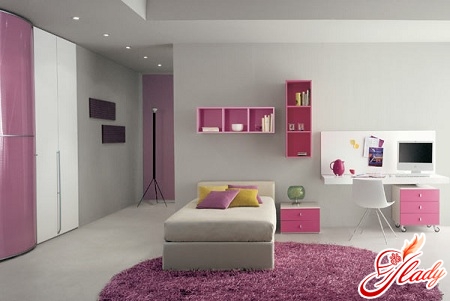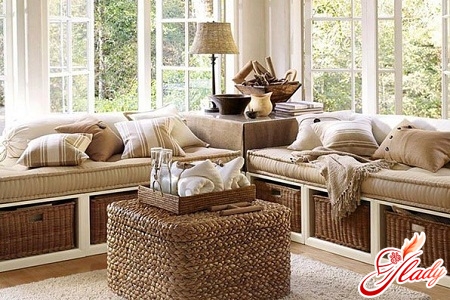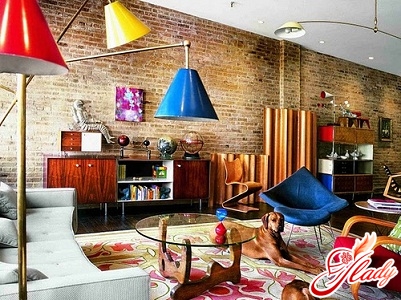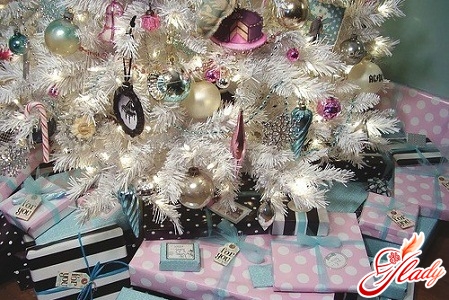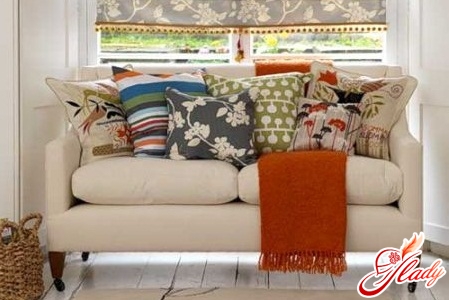 Knitted bedspreads, pillows, capes and blankets,weightless chiffon and luxurious silk, exquisite brocade and laconic linen… All this can bring coziness to any interior and literally transform the house. And the thing is that textiles (both factory and hand-made) are one of the main components of interior design. Textiles in the interior provide unlimited scope for creativity and the implementation of the most daring design fantasies. Correctly selected fabrics, skillful draperies, tablecloths, capes and furniture covers are often used in professional design techniques. Matching or contrasting with the decoration of the room, they not only decorate the house, but also add individuality, mood and chic to it. Textiles in the interior will bring real pleasure to both the artist who decorates the house and those who will live in this house. Of course, only if everything is done correctly, with taste, in accordance with fashion trends and stylistic directions. In addition, interior textiles are so versatile that they can be used to implement a wide variety of design ideas. Let's refresh our memory on the most common options for using textiles in the interior.
Knitted bedspreads, pillows, capes and blankets,weightless chiffon and luxurious silk, exquisite brocade and laconic linen… All this can bring coziness to any interior and literally transform the house. And the thing is that textiles (both factory and hand-made) are one of the main components of interior design. Textiles in the interior provide unlimited scope for creativity and the implementation of the most daring design fantasies. Correctly selected fabrics, skillful draperies, tablecloths, capes and furniture covers are often used in professional design techniques. Matching or contrasting with the decoration of the room, they not only decorate the house, but also add individuality, mood and chic to it. Textiles in the interior will bring real pleasure to both the artist who decorates the house and those who will live in this house. Of course, only if everything is done correctly, with taste, in accordance with fashion trends and stylistic directions. In addition, interior textiles are so versatile that they can be used to implement a wide variety of design ideas. Let's refresh our memory on the most common options for using textiles in the interior.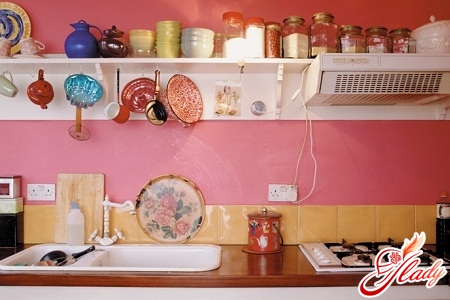
Window Textiles
Window draperies are perhaps the most popularthe way of using fabrics in the interior. In addition, window design today (and in the past too) is one of the most important elements of the interior as such. The overall impression of the living space largely depends on how the window is decorated. This is easily explained by the fact that anyone entering the house first of all glances at the window - the source of light. Different styles have their own traditions of window decoration, which emphasizes the general atmosphere of the room on its luxury or modesty, formality or comfort, sophistication or simplicity, businesslike or frivolous. Therefore, the color of the fabric for window curtains, its pattern and texture, as well as the cut and method of assembling the curtains can not only emphasize the stylistic solution of the room, but also, alas, bring dissonance to the harmony of the home. For example, linen curtains are appropriate when decorating an interior in eco-friendly styles, organza and brocade - in ethnic and romantic, cold silk - in the high-tech style, and velvet is already a privilege of classicism and baroque. Pastoral flowers on curtains, checks and stripes are French Provence, German Biedermeier and Western country, and plain-colored curtains in pastel colors or rich colors and arabesques are already the "breath of the East". If we talk about fashionable trends in window decoration, then it is appropriate to dwell on two main (and opposite) directions. The first is multi-section drapery, the second is the absence of additional fabric decoration. In the first case, the curtains are given an impressive look due to the special cutting of the fabric, multi-layering and exquisite drapery. The second option focuses all attention on the quality, texture and color of the fabric, when it simply covers the window without additional grabs and gathers (Japanese or Roman blinds).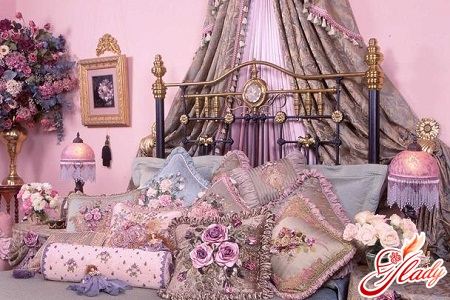
Bedding Textiles
Textiles for the bedroom interior are, of course,the topic is quite intimate. But here too everything is subordinated not only to functionality and direct purpose, but also to the laws of interior design. One thing is eco-friendly fabrics for children's bed linen, another is a comfortable bed for an elderly person and quite another is a romantic or passionate bed of love. Despite the privacy of this element of the interior, bed linen textiles can easily compete in importance with window textiles. Among all the directions of textile design for the bedroom, two can be distinguished: traditional and minimalist. Minimalism is, first of all, functionality, laconicism and simplicity, natural fabrics, calm tones and strictness of bed linen. The traditional stylistic direction is a special bliss, sentimentality, coziness and all sorts of "decorations". Here is where lovers of comfort, romantic natures and admirers of sophistication can turn around. In addition to soft pillows and blankets, these are also bedside canopies and baldachins, as well as bed linen of all kinds of styles and colors. In addition, bedspreads are also a very important element of bedroom interior design, especially if they match the design of the window curtains.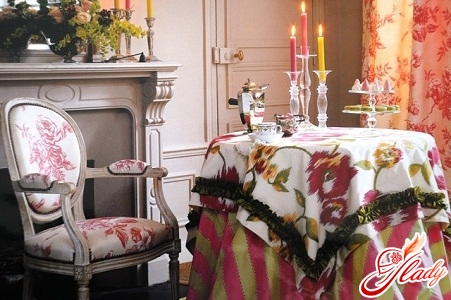
Table textiles
As for textiles in the dining room interior,fashion for it is quite conservative. Table linen is tablecloths, napkins and towels, the most common fabrics for which are linen and cotton. Of course, we should not discount such a gift of scientific and technological progress as new synthetic materials (waterproof, wrinkle-resistant, etc.) that are actively used in the production of table linen, but at the same time skillfully imitate the texture and appearance of natural fabrics. Decorations for table linen remain classic - lace, openwork, embroidery, figured edging. And table linen itself has almost become an interior decoration and holiday attribute. Any special event is firmly associated with starched tablecloths and beautifully folded napkins. In interior design with the help of table linen, the same rules continue to apply:
- The overall tone of the tablecloth should be lighter than the main (predominant) color in the interior;
- napkins can be the same color with a tablecloth, and also much darker or lighter;
- a combination of napkins and tablecloths of different colors is acceptable, and a combination of contrasting tablecloths with multi-layered decoration of the tola;
- The color of table linens affects appetite: orange, red and white increase it, while blue and black dampen it.
The category of festive table textiles can bealso include replacement chair covers. Firstly, such covers will allow you to give the interior the desired mood without unnecessary costs and will create an atmosphere of special solemnity or a cheerful, relaxed holiday. But chair covers, most likely, already belong to the category of furniture textiles.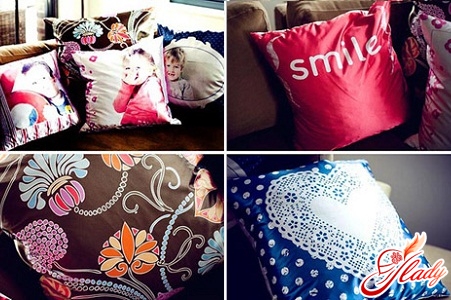
Furniture textiles
In addition to the already mentioned chair covers, this"Clothes" can be purchased (or made by yourself) for other furniture. Of course, we are talking about upholstered furniture - sofas, armchairs, poufs. Covers for upholstered furniture can be everyday and perform protective functions (this is especially true for expensive or elite furniture). Or, on the contrary, the cheapest and most unpresentable sofas and armchairs with the help of covers will turn into the highlight of your interior, emphasize its style and set the right tone. Another element of furniture textiles - capes - serves in the same capacity. They are easy to replace, easy to wash (or clean) and also easy to make (cut, sew, knit). Sofa cushions - dumki can also set the mood for the interior. The choice of the shape of such cushions, their color and decoration can vary the mood of your home from nostalgic to the most frivolous. And there is no need to talk much about the additional feeling of coziness that sofa cushions create. Furniture textiles are especially relevant when you are already tired of the usual upholstered furniture, but its service life has not yet expired. It is too early to change it, but you want a change. That is when replaceable covers, capes and bedspreads come to the rescue, the choice of materials for which is almost limitless - from the densest and heaviest to weightless and "shaggy". Having such replaceable clothes, you can update the furnishings in your home several times a year, depending on the season or your own mood. In general, decorating the interior with textiles is a rewarding activity. Perhaps, there is no such design task that could not be solved with the help of textiles. The same fabric in different houses looks different, and also performs different tasks, so its main secret is to emphasize individuality. And there are more than enough opportunities for this. The matter is small - to realize all these (or just some) "material" possibilities.





